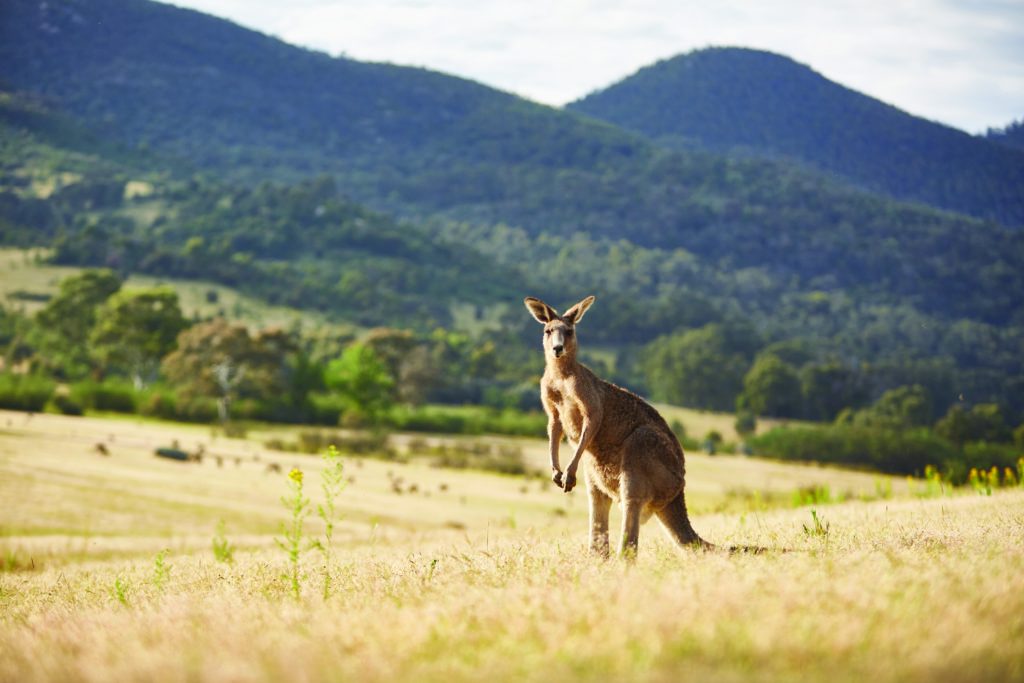
The 2018 Canberra kangaroo cull is up by 1000 on last year to 3252. Photo: Visit Canberra.
Canberra’s 2018 kangaroo ‘cull’ will number up to 3252, and is a thousand more than last year. The shooting will cost up to $500,000.
At the launch of the cull on 2 May 2018, RiotACT spoke to ACT Government Ecologist, Doctor Melissa Snape, about the success of a recent trial on dart delivered contraceptives for kangaroos.
The ACT Government has two years of data for the hand-delivered contraceptive and one years for the dart delivery process.
“We are seeing 80 percent success in the first year that goes up to 100 percent once all of the pouch young move out of the pouch,” Dr Snape said.
Dr Snape said because nature reserves in the ACT were fragmented, with suburbs and roads, the movement of kangaroos is restricted, and there is a need to manage their impact on the grassy habitat for all animals.
“We are doing a lot of research into the relationships between kangaroos on those grassy ecosystems and what level of kangaroos is most appropriate, and the different tools that are needed to achieve that,” Dr Snape said.
The ACT Government does annual kangaroo population counts for each reserve.
“We look at the vegetation structure and then work out the appropriate number of kangaroos for each reserve,” Dr Snape said.
The kangaroos will be buried and there are no plans for any commercial use of dead animals.
“The ACT doesn’t have a commercial use of carcasses and the cull numbers wouldn’t support a commercial industry,” Dr Snape said.
This year’s cull will mean several nature reserves and adjacent territory land will be closed from Monday 7 May to Thursday 26 July, from late afternoon until early morning each day (details below), to allow the shooting of up to 3253 Eastern Grey Kangaroos.
The kangaroo cull may finish earlier depending on progress.

ACT Government Ecologist, Doctor Melissa Snape at the announcement of the 2018 ACT kangaroo cull and the release of three reports into kangaroo management in the ACT. Photo: Tim Benson.
Director of ACT Parks and Conservation Service, Daniel Iglesias, said,“Kangaroos are an integral part of the ecosystems around Canberra. The conservation cull of up to 3253 Eastern Grey Kangaroos protects biodiversity and maintains kangaroo populations at appropriate levels to minimise impacts on other plants and animals in critical grassland and woodland sites.”
During the conservation cull, up to 1822 kangaroos will be culled from reserves across the ACT, and up to 1431 kangaroos from Googong Foreshores, which is managed by the ACT Government.
“The Googong Foreshores area must be protected as it contains threatened species and ecological communities and forms part of an important wildlife corridor that extends from the Tinderry Range in NSW to north-eastern ACT,” Mr Iglesias said.
“Our ecologists have used the best current scientific knowledge to analyse the status of each reserve’s population, the amount and type of vegetation, rainfall and other relevant factors to determine the numbers to be culled to support conservation outcomes.”
In addition to the announcement of the 2018 kangaroo cull, three reports into Canberra’s kangaroos were also released today:
- Fertility Control of Eastern Grey Kangaroos: Assessing efficacy of a dart-delivered immunocontraceptive vaccine
- Kangaroos and Conservation: Assessing the effects of kangaroo grazing in lowland grassy ecosystems
- Factors Influencing Sub-adult Mortality Events in Eastern Grey Kangaroos
“Our research into the use of a fertility control vaccine as a potential non-lethal approach to kangaroo management is showing positive preliminary results but is not an easy or quick solution,” Mr Iglesias said.
Trials to date have demonstrated the contraceptive agent ‘GonaCon’ can be effectively delivered to kangaroos remotely using a dart, achieving a high rate of contraception in treated animals after one year.
“We will need several more years of monitoring the treated animals before we can conclusively say it is an effective and practical form of population management,” Mr Iglesias said.
We’re LIVE from Weston Park where ACT Parks and Conservation Service will announce the start of the annual conservation cull of Eastern Grey Kangaroos.
Posted by The RiotACT on Tuesday, May 1, 2018
One report explores the relationship between kangaroos and their environment by looking at kangaroo density, grazing pressure, ground layer habitat structure and indices of biodiversity.
Another looks at why ‘die-off’ events happen among sub-adult kangaroos.
It shows that sub-adult kangaroos in high-density populations have poorer body condition compared to those in lower density populations where more food per kangaroo is available.
“This new research will allow us to strengthen the models that underpin our kangaroo management program,” Mr Iglesias said.
The following sites will be closed during the cull from 7 May to 27 July:
3 pm to 7 am:
- Callum Brae Nature Reserve
- East Jerrabomberra Grasslands
- Kama Nature Reserve
5 pm to 7 am:
- Aranda Bushland Nature Reserve and adjoining land
- Mount Mugga Mugga Nature Reserve
- Isaacs Ridge Nature Reserve and Isaacs Pines
- Isaacs Ridge Nature Reserve
- eastern slopes of Mount Ainslie Nature Reserve
6 pm to 6 am:
- Mulligans Flat Nature Reserve, except Wednesdays and Fridays
- Goorooyaroo Nature Reserve
6 pm to 8 am:
- Googong Foreshores
*This article first appeared on RiotACT






